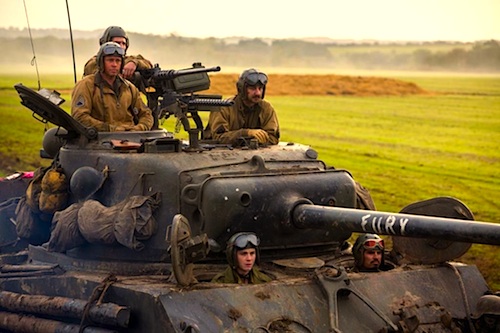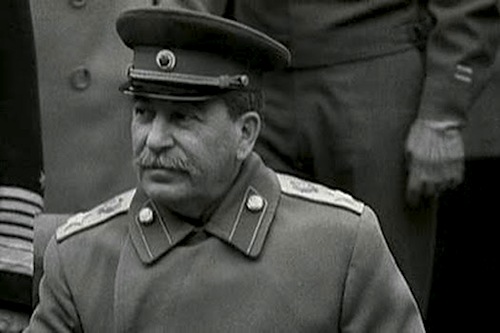By Joe Bendel. Sherman tanks such as the one Sgt. Don “Wardaddy” Collier commands were like portable Alamos. During WWII, American tank crews suffered staggering losses to Germany’s superior armored forces, but they could still do a lot of damage before their number came up. Essentially, that was also the strategy of the fanatical German remnants, who refused to recognize National Socialism’s imminent defeat. Instead of a march to victory, a new post-Normandy addition to Collier’s crew will have the mother of all fiery baptisms in David Ayer’s Fury, which opens tomorrow nationwide.
For years, Collier has beat the odds, somehow bringing his men safely through each battle. Unfortunately, his luck, or at least his machine-gunner’s, has just run out. For a replacement, he is stuck with Norman Ellison, a transfer from clerical services, who could not possibly be anymore naïve. In contrast, the German-speaking Collier has no illusions about the nature of war or the enemy they face. His tank, “Fury,” is indeed aptly named, reflecting his general attitude, particularly when it comes to the SS.
Of course, Ellison will take plenty of not-so good-natured ribbing from his new brothers-in-arms: Boyd “Bible” Swan, the token fundamentalist, Trini “Gordo” Garcia, the token Hispanic, and Grady “Coon-Ass” Travis, the token sociopathic jerkweed. When the rookie Ellison makes a mistake that leads to the death of another crew, Fury becomes an even more tense and awkward place to be. However, Collier is determined to make a stone cold killer out of Ellison, one way or another. The process might even involve a fair amount of climatic heroics.
Frankly, Fury’s first act is a tonal traffic accident, designed to shock us out of our supposed “jingoism” and rub our noses in the war crimes committed by the Greatest Generation. We see a lot of Collier dispatching surrendered Germans, until some script editor apparently noticed the film was making the Nazis look sympathetic. As a result, the second act is a sort of war crimes poker game played out between Collier and the SS, in which battlefield executions are called and raised with strafed civilians.
It is a darned shame Ayer wastes so much time trying to be hip and revisionary, because when Fury gets down to the a-man’s-gotta-do-what-a-man’s-gotta-do action, it is pretty spectacular. The early battle scenes are certainly tense and brutal, but they also clearly and dramatically establish the mechanics and dynamics of armored combat. They are all well staged, but the big centerpiece showdown-conflagration is an instant classic. (Sensitive viewers should be warned: there are graphic scenes of limbs severed by all manner of projectiles and explosives.)

Without question, Fury features the best tank-fighting sequences ever staged on film. Unfortunately, the further they get from the Sherman M4, the shakier the film gets. As a case in point, an overly long sequence in which Swan, Travis, and Garcia crash a quiet moment Collier and Ellison are trying to have with two German women makes no sense within the film’s dramatic context. They are supposed to fear and revere Collier, but they are acting like knuckle-dragging savages, just to make the audience hate them.
Nevertheless, Brad Pitt gets down to business quite effectively and efficiently as Collier. He is one of the few contemporary American screen actors with genuine movie star presence, but he is still completely credible playing a grizzled hardnose. Shia LaBeouf is also surprisingly flinty as Swan, so his reported self-mutilation did not go to waste. As Ellison, Logan Lerman also brings more grit and substance to the table than one might expect. Conversely, Jon Bernthal’s Travis is all bug-eyed shtick, while Michael Peña’s Garcia has really no distinguishing personality traits whatsoever.
There is a real disconnect between the extraordinary armored combat scenes and Ayer’s problematically erratic screenplay. Flirting with moral equivalency, he keeps telling us war is Hell when he is not blowing stuff up real good. Still, Pitt and the awesome warfighting scenes are just enough to carry the day. Recommended for fans of war movies, Fury opens wide tomorrow (10/17), including the AMC Loews Lincoln Square in New York.
LFM GRADE: B-
Posted on October 16th, 2014 at 2:40pm.

